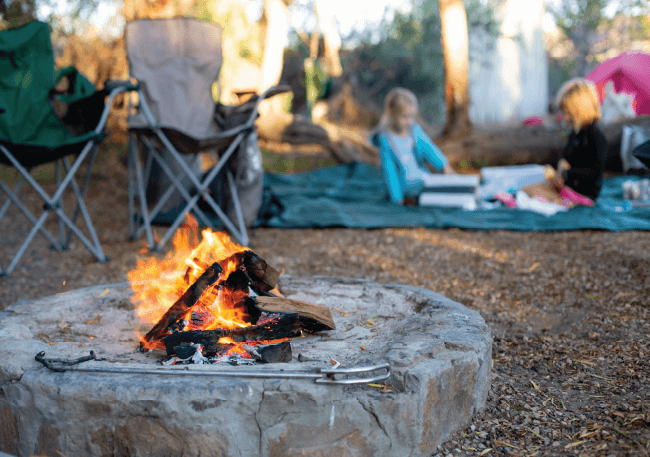Some of the best memories, friendships and moments with God happen during church camps. And to those organising the camp, there is a responsibility to plan an enriching event and limit the danger and risks.
Camps typically incorporate diverse activities, such as sports, campfires, adventure programs like High Ropes or Flying Foxes, and water-based activities like surfing or swimming. Church camps, while incredibly enriching, inherently involve a level of risk. This is where our expertise in Church insurance and protection proves to be invaluable.
Acceptable risks come with clear benefits that align with the overall goal of the camp, and we can handle them well with sound risk management. Suppose a risk of an activity doesn’t hold real value and could cause harm. In that case, it’s best to omit that activity and thereby omit the risk.
All of this comes down to a clear understanding of what the goal of the church camp is.
Below are six questions to consider when putting together a robust camp goal.
1. What is your spiritual objective
2. What activities are you planning? (some of these depend on the venue)
3. How are you planning on communicating with key stakeholders?
4. What are your measurable outcomes?
5. How does this camp align or build into your church values?
6. How long is the camp? And how does this impact resources?

Example 1:
Our goal is to host a marriage weekend getaway for 50 couples who feel stressed, tired and overwhelmed. This relaxing long weekend retreat aims to enable them to be refreshed and have quiet moments with each other and God.
This goal already indicates the type of activities that would be unsuitable based on their age, stage in life and the event’s theme.
Example 2:
Our CBD church is going to take the youth to a rural lake campsite for one week, where they will learn practical and spiritual skills and have the chance to disconnect from social media and build real connections with their peers and leaders.
With this goal, you can already see how aquatic risk management, mobile phone reception plans and injury prevention will be vital in creating an exceptional and safe experience.
Therefore, it becomes essential to adopt a comprehensive risk management strategy.
Insert Risk Assessment
But why does this responsibility fall on the church? Shouldn’t the parents, children or others involved take responsibility for their actions? This is where Duty of Care comes in.
Duty of Care
The duty of care for a church during camps is a moral and legal obligation to ensure participants’ safety, well-being, and proper supervision. This duty extends to all camp members, including campers, volunteers, staff, and leaders. Here are critical aspects of the duty of care for a church during camps:
1. Child Protection:
- Background Checks: Churches have a legal responsibility to ensure that individuals working with children undergo thorough background checks and have the appropriate Working With Children Check applicable to your State or Territory. Even if specific tasks or activities are delegated to volunteers or external groups, the church is responsible for ensuring that all people engaging with children have the proper background checks in place.
- Risk Assessment: When organising events, camps, or activities, the church has a responsibility to conduct thorough risk assessments for all proposed activities. This includes identifying potential hazards, implementing safety measures, and ensuring that all participants are adequately supervised.

2. Spiritual Guidance and Counseling:
- Pastoral Care: Church members’ spiritual and emotional well-being can be overlooked when considering camps. It could be worth discussing how you may approach situations where someone is in distress, has a spiritual encounter or wants to know more about the next steps in the Christian faith.
3. Worship Services and Facilities:
- Safety during Services: The church has a duty of care to ensure the safety of attendees during worship services. This includes maintaining safe facilities, adhering to building codes, and having emergency procedures in place.
4. Incident Reporting Procedures:
- It is essential that all organisers and leaders have a thorough understanding of the organisations Child Protection Policies and Procedures, and that clear instructions are provided on the correct process for reporting incidents and accidents, including how to complete an incident report form and who to notify in the event of something going wrong.
Policy and Planning
The planning process should incorporate a site inspection for your camp or excursion and a face-to-face meeting with providers. This holds true regardless of whether the church uses the facilities for the first time or if the location has been a staple for many years. The comprehensive set of policies and procedures should encompass, but not be limited to:
- Emergency Management Plan
- Training for volunteers and leaders
- First aid training and supplies
- Permission slips from parents
- Risk Management Plan
- Incident Management policies and procedures
- Safeguarding or Child Protection Policy
- Code of Conduct for Those Attending
- Code of Conduct for Staff and Volunteers
- Engagement of Volunteers
- Camp Policy
Permission form:
Here are other things to consider regarding policy and planning relating to specific activities around adventure activities, travel to and from camp and aquatic activities.
• Parent/carer consent procedure.
• Assessment of participants’ abilities and health.
• Water conditions assessment (location, size, depth.
• Training and qualifications needed for leaders and providers.
• Verification of safety standards compliance by provider and facility.
• Supervision guidelines, including leader/child ratios.
• Provider’s emergency plans.
• Identification of potential environmental hazards.
• Accessibility of communication and rescue equipment in emergencies.
• Analysis of environmental variables’ impact on the site.
Emergency Management Plan
Your organisation and the camp need a well-defined Emergency Management Plan that articulates the policies, procedures, and resources that will be employed in addressing emergencies.
All staff and volunteers must familiarise themselves with the specifics of the Emergency Management Plan applicable to your organisation and the camp. Following the camp’s risk management policies involves the following:
Access to First Aid:
- Know the procedures for accessing first aid resources at the camp and understand the location of first aid kits and the individuals trained to administer aid.
Knowledge of Local Medical Services:
- Familiarise yourself with the nearby medical services, including the locations of ambulances and hospitals. Establish a management plan, including incident recording, if an injury or illness occurs.
Insurance Understanding:
- Ensure a clear understanding of the insurance coverage provided by your organisation and the camp. Familiarise yourself with the extent of coverage for various scenarios.
Incident management
From the moment an incident occurs to its investigation and ongoing management, a well-defined system is critical to a seamless.
Every detail is crucial, making timely incident report creation paramount. Delaying documentation risks accuracy as memories fade with time. The circumstances of the incident must be documented whilst all the facts are fresh in people’s minds. Ensure that leaders are have clear instructions about the correct process to notify and record an incident, and who the matter should be reported to.
Safeguarding
Safeguarding involves taking steps to protect children and vulnerable adults from harm and abuse. When organising a camp, ensuring that everyone responsible for these groups knows how to respond to safety concerns is crucial.
Leadership and staff members should undergo training in safeguarding procedures. This includes recognising signs of abuse or grooming and understanding how to handle incidents. The church organisation should have a clear and detailed Child Protection Policy. This policy outlines their commitment to protecting children and specifies the procedures for ensuring their safety during camp activities.
Volunteers

It is crucial for organisations, particularly churches, to ensure proper insurance coverage for volunteers as they may not be protected under traditional worker’s compensation policies, unlike paid employees. The absence of coverage for volunteers can pose challenges in cases of accidents or injuries during volunteer activities. When reviewing insurance policies, organisations should assess whether volunteers are included in the coverage and consider alternative solutions, such as volunteer personal accident insurance.
We have many resources on looking after volunteers, including our Valuing and Protecting our Volunteers article.
Insurance
Your peace of mind and the well-being of all involved depend on the proper coverage. Here are vital questions to consider:
Sexual Abuse Protection:
- Does your insurance encompass Sexual Abuse protection? This specialised coverage is essential in safeguarding against unforeseen incidents during the camp.
Public Liability Insurance:
- Does your insurance include Public Liability coverage? This broad coverage offers comprehensive protection against various potential issues that may arise during the camp. Examples include loss, damage or injury to a third party or their property resulting from negligence or the church’s breach of duty of care.
Communication with the Camp:
- Have you engaged in discussions with the camp about their insurance? Understanding the camp’s insurance coverage is pivotal. It ensures alignment with your needs and helps gauge the level of protection they offer.
Camp’s Insurance Adequacy:
- Does the camp possess insurance that adequately protects you? Do any of their contracts include “hold harmless” clauses which requires you to assume all liability regardless of fault? If so, speak to your insurer before signing any waivers to ensure you are not compromising your cover. Clarify the camp’s insurance provisions to ensure your interests are adequately covered.
Consultation with Your Broker or Insurer:
- Have you consulted with your insurance broker? Your broker is a valuable resource in navigating the intricacies of insurance. Ensure your broker is apprised of the camp’s specifics to tailor your coverage accordingly.
Taking proactive steps to address these questions is integral to creating a secure environment for your camp. Safeguarding against potential risks and uncertainties requires a comprehensive understanding of your insurance coverage and alignment with the camp’s provisions. Prioritise these discussions to guarantee all participants a safe and protected camp experience. We are experts in this space – so do reach out on 1800 646 777 to discuss further

Preparing for your camp
Preparation is the key to organising your camp. Here is a handy timeline and checkpoints you can tick off.
12-6 months before camp
- Assess the church community’s needs
- Identify the target community
- Estimate the number of participants
- Involve group leaders and church board
- Collaborate with youth group leaders or community leaders.
- Write camp goals
- Start venue enquiries
- Enquire about how they approach their insurance and risk management.
Venue research:
When researching a church camp venue, there can be a lot to consider. So, to help you, you’ll find at the bottom of this article a comprehensive checklist of things to look out for.
3-6 Months Before Camp
Staff-Participant Ratio:
- Identify the recommended staff-participant ratio, which varies depending on the state in Australia.
Write Itinerary and Program
Site Visit and Risk Assessment:
- Conduct a site visit to assess camp facilities, accommodation layout, and catering arrangements.
- Undertake a thorough risk assessment to identify and address potential hazards.
- Review emergency management procedures provided by the camp.
Staff and Volunteer Roles:
- Identify specific roles, required skills, and necessary experience for staff and volunteers.
- Begin recruitment or selection process based on identified criteria.
Insurance Documentation:
- Obtain and review the camp’s insurance Certificate of Currencies.
- Ensure that the insurance coverage is comprehensive and suitable for the planned activities.
Parental Involvement and Communication:
- Develop a strategy to communicate camp details and objectives to parents.
- Consider strategies for parent buy-in, especially if a significant cost is involved.
- Brainstorm fundraising ideas, savings plans, or potential sponsorships to offset costs.
2 Months Before Camp
1. Review Camp Policies and Procedures:
- Thoroughly review and reaffirm the camp’s policies and procedures.
- Pay specific attention to incident management protocols and safeguarding commitments.
3. Leadership Team Confirmation:
- Confirm the availability and commitment of the leadership team.
- If using volunteers, initiate advertising, conduct interviews, and engage them in the camp’s vision.
4. Camp Information Distribution:
- Begin distributing camp information to participants and parents or guardians.
- Include crucial details such as camp dates, venue, accommodations, activities, cost breakdown, and payment methods.
- Provide information on safeguarding policies and procedures for a secure environment.
4 Weeks Before Camp
As the anticipation for the upcoming camp intensifies, ensuring that the leadership team is well-prepared and equipped for the responsibilities ahead is crucial. Here’s a comprehensive agenda for a leader’s meeting held four weeks before the camp:
Leader’s Meeting Agenda: 4 Weeks Before Camp

1. Skills and Roles Overview:
- Provide a detailed overview of the skills possessed by each member of the supervisory team.
- Clearly define roles and responsibilities to ensure a cohesive and efficient leadership structure.
2. Camp Program and Goals:
- Review and discuss the camp program, emphasising the goals and objectives set for the participants.
- Ensure that the leadership team is aligned with the intended outcomes of the camp.
3. Incident Management and Emergency Procedures:
- Outline the incident management processes, emphasising swift and effective responses.
- Provide a thorough understanding of medical control, emergency management, and safeguarding procedures.
4. Emergency and Contingency Plans:
- Discuss and familiarise the team with emergency and contingency plans to address unforeseen circumstances.
- Ensure that every member understands their role in implementing these plans seamlessly.
5. Individual Support and Communication Needs:
- Identify and address individual support and communication needs, particularly where appropriate.
- Foster an environment that caters to the diverse requirements of participants, staff, and volunteers.
6. Specialised Leader Confirmation and Training:
- Safeguarding Leaders:
- Confirm individuals assigned to safeguarding roles.
- Ensure they undergo the necessary training to fulfil their responsibilities effectively.
- Incident Management Leaders:
- Identify leaders responsible for incident management.
- Provide specialised training to equip them for potential scenarios.
- First Aid Leaders:
- Confirm leaders designated for first aid duties.
- Ensure they undergo comprehensive first aid training.
- Medical Support Leaders:
- Identify leaders responsible for recording and managing medical, support, and communication needs.
- Provide training to ensure thorough understanding and capability.
1-2 Weeks Before Camp
Finalise Responsibilities:
2. Emergency and Contingency Plans:
- Review and reinforce emergency and contingency plans with the leadership team.
3. Logistics Confirmation:
- Confirm transport details and departure times for all participants.
4. Administrative Tasks:
- Ensure all necessary camp forms and any outstanding fees are collected.
5. Individual Support Needs:
- Address individual support needs of participants
7. Health and Safety procedures:
Organising a church camp is fulfilling but requires careful planning and a solid commitment to safety. We hope the resources and checklist give you a good starting place as you begin the journey.
If you need to talk to us about risk management and insurance options, we are the experts in this space. Give us a call on 1800 646 777 or connect via the website.
Venue Checklist
Location:
- Accessibility: Ensure the venue is accessible for all participants, considering travel distance and transportation options.
Facilities:
- Accommodation: Check the quality and capacity of lodging facilities to accommodate the expected number of participants comfortably.
- Meeting Spaces: Ensure suitable spaces for worship, meetings, and group activities.
- Recreation Areas: Look for recreational areas that align with your planned activities, such as sports fields, hiking trails, or waterfront access.
Safety and Security:
- Emergency Services: Verify the proximity of emergency services, hospitals, and medical facilities.
- Security Measures: Assess the venue’s security measures, including lighting, fencing, and on-site security personnel.
Amenities:
- Kitchen and Dining Facilities: Ensure that the kitchen and dining facilities meet the needs of your group, including dietary restrictions.
- Restrooms and Shower Facilities: Check the condition and cleanliness of restroom and shower facilities.
Regulations and Permits:
- Permits and Zoning: Verify that the venue has the necessary permits and complies with local zoning regulations.
- Noise Restrictions: Check for noise restrictions or rules impacting your planned activities.
Capacity and Size:
- Capacity: Confirm that the venue can comfortably accommodate the expected number of participants.
- Outdoor Space: Assess the availability of outdoor space for group activities and games.
Cost and Budget:
- Costs and Fees: Clearly understand all costs associated with the venue, including rental fees, deposits, and additional charges.
- Budget Alignment: Ensure that the venue cost aligns with your budget constraints and financial capacity.
Accessibility for All:
- Accessibility for Disabilities: Check if the venue is accessible for individuals with disabilities, including ramps and accessible restrooms.
Reviews and Recommendations:
- Past Experiences: Research reviews or testimonials from groups that have previously used the venue.
- Recommendations: Seek recommendations from other churches or organisations.
Tech and Equipment:
- Audio-Visual Equipment: If needed, confirm the availability of audio-visual equipment for presentations or worship services.
- Internet Access: Check for reliable internet access if communication or online resources are required.
Catering and Food Services:
- Catering Options: Evaluate catering options, considering your group’s dietary restrictions and preferences.
Flexibility and Adaptability:
- Flexibility in Schedule: Confirm if the venue allows flexibility in scheduling activities and services.
- Adaptability: Ensure the platform can accommodate any requirements or changes to the original plan.


